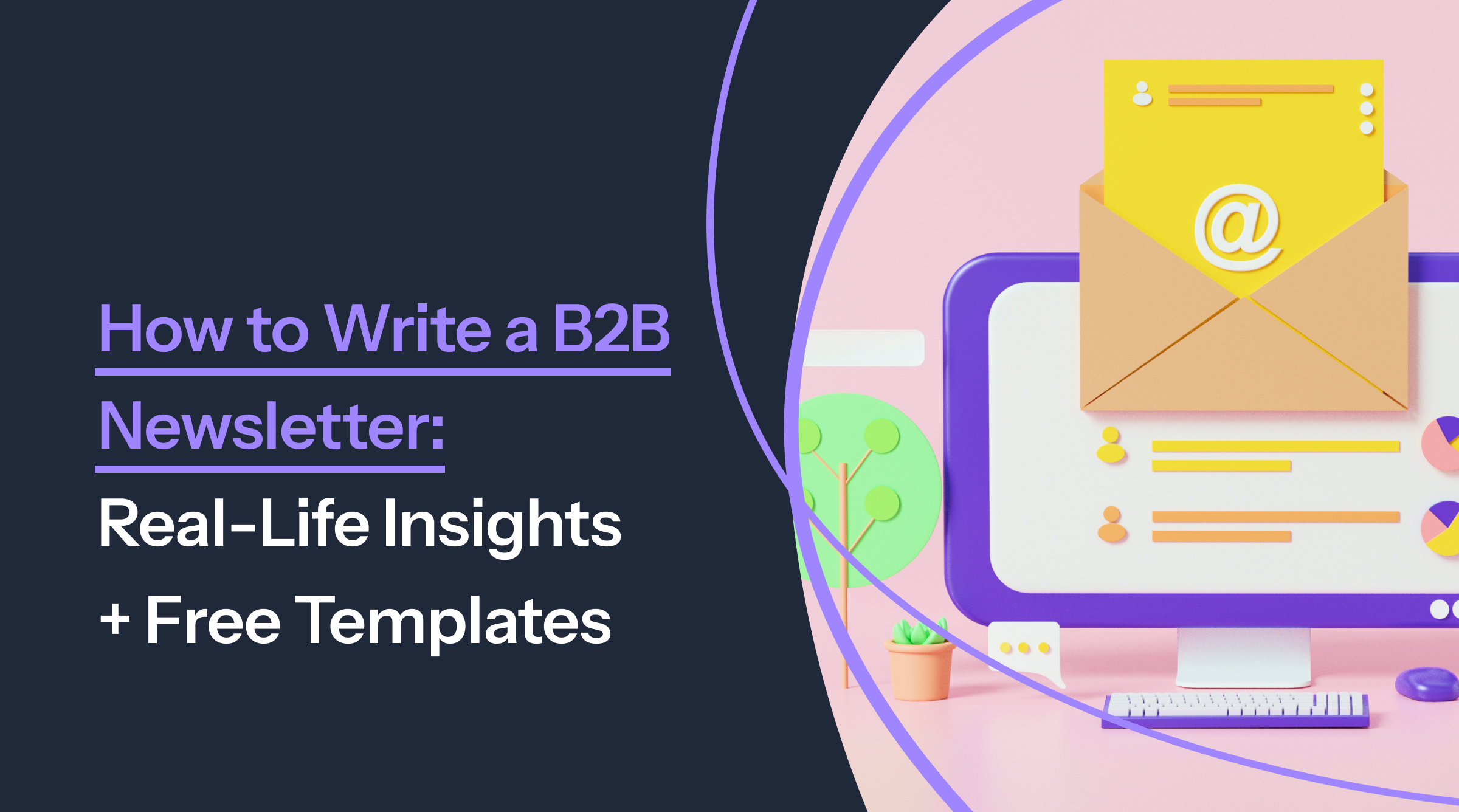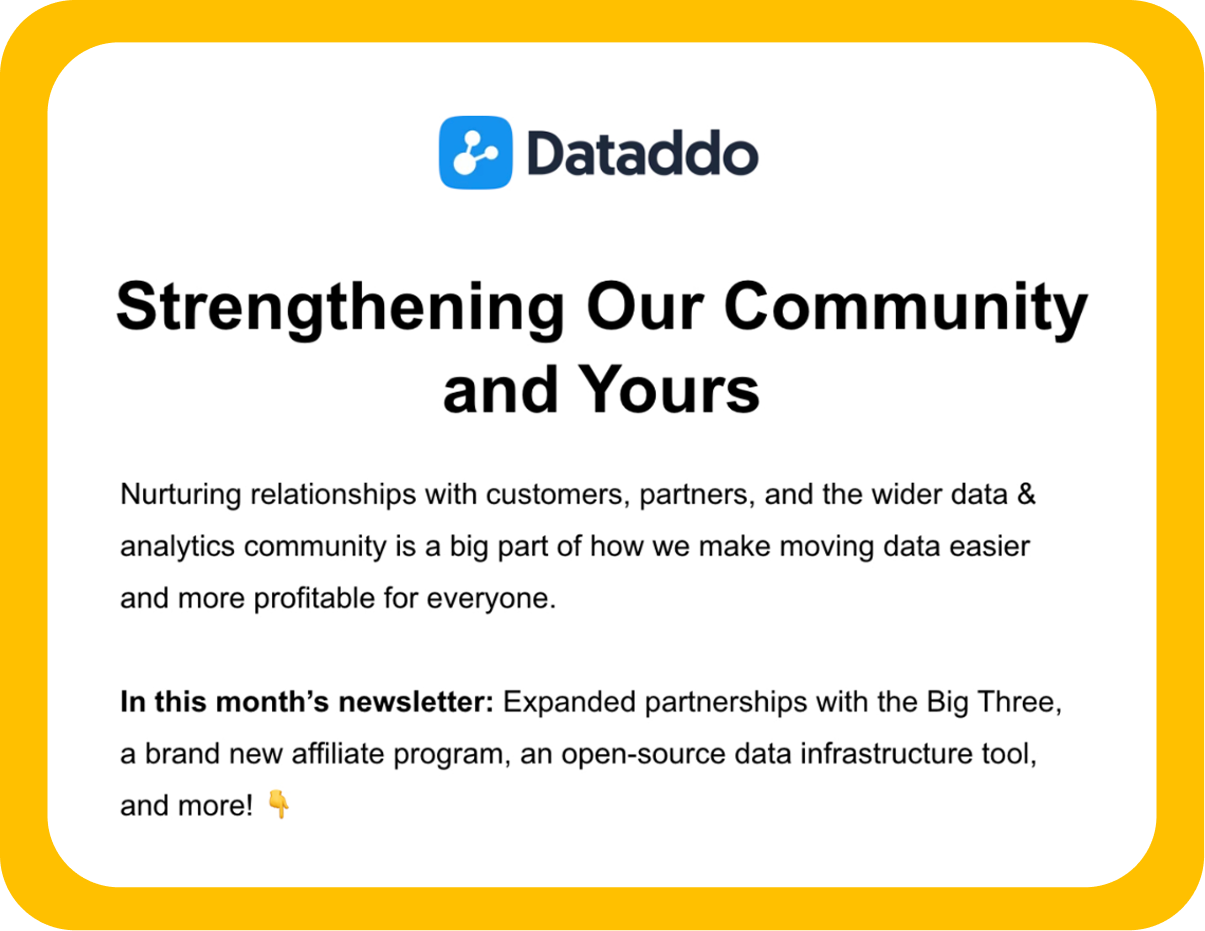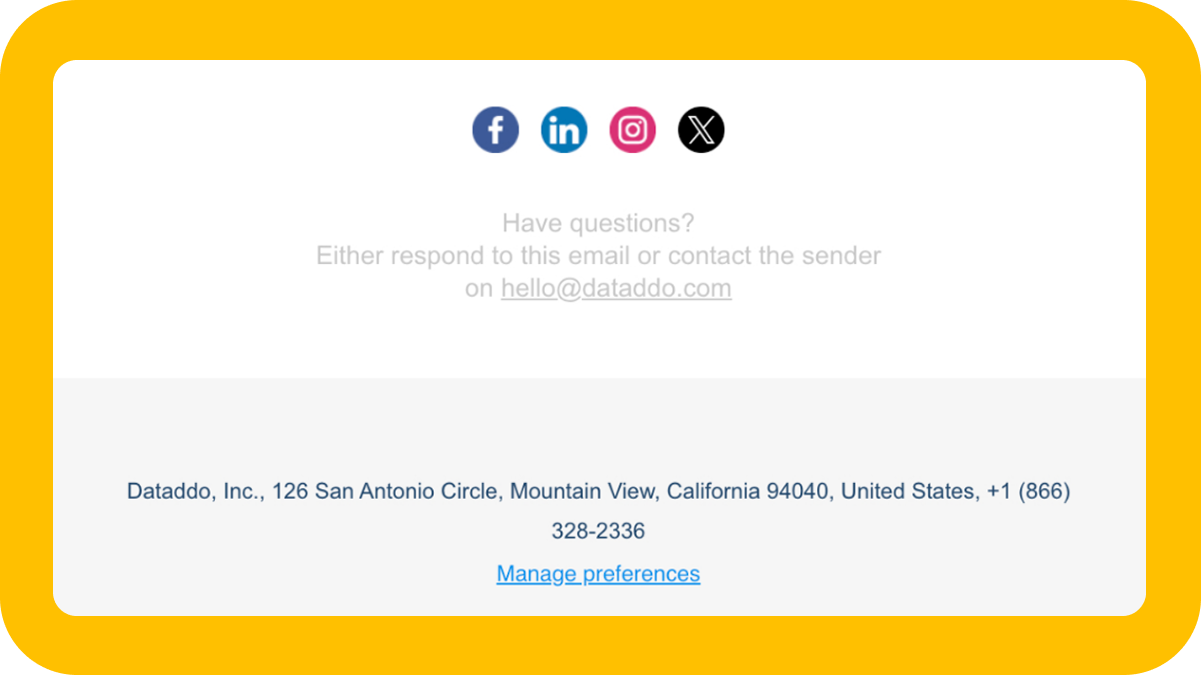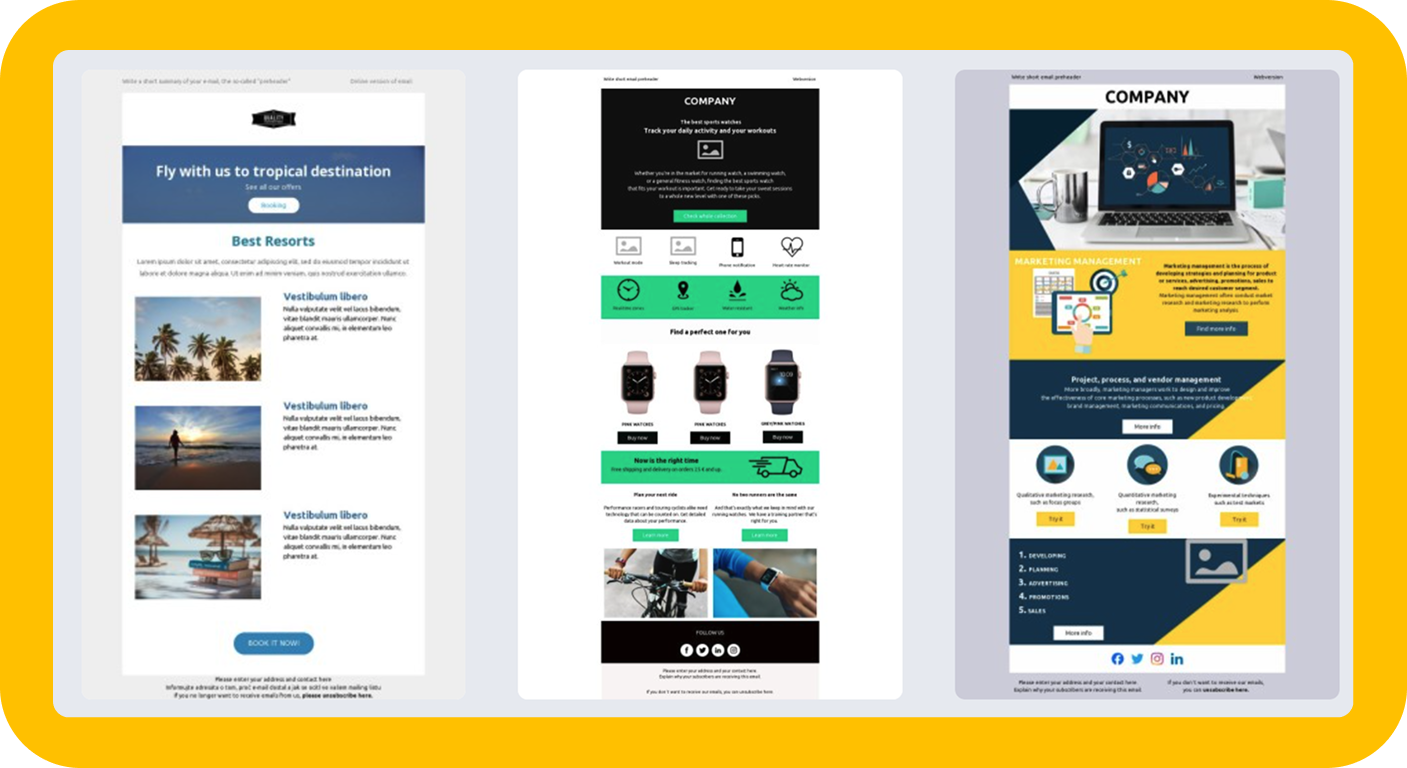How to Write a B2B Newsletter: Real-Life Insights + Free Templates
Writing a newsletter to your existing, potential, and even former clients is a superb way to retain and attract business. It’s easy, doesn’t cost much, and speaks to an audience that has already explicitly agreed to receive communications from you.
We at Topol.io, makers of a world-class email editor, have had years of experience sending B2B newsletters, and in this article we’ll walk you through how to maximize their impact—from planning, to writing, to executing, to tracking. We’ll also share our free templates to help you get your own B2B newsletter ideas off the ground.

*If you want to learn about how to write an internal newsletter for company employees, see our article on how to write an employee-facing newsletter.
The Aims of B2B Newsletters
Have you ever heard that it’s more cost-effective to keep existing customers than to acquire new ones? Keeping existing customers engaged is the primary aim of business-to-business (B2B) newsletters and why around 80% of B2B marketers use them.
B2B newsletters help you:
Make your customers feel that you are continually delivering value to them
Make your customers feel that they have an impact on how your product or service develops
Make your customers feel like a partner
Upsell (e.g., present opportunities for upgrades)
Reactivate old or expired accounts
These aims differ from those of business-to-customer (B2C) newsletters, which often entice recipients to make quick purchases using discounts. B2C newsletters won’t be the focus of this article.
The main metrics for measuring the impact of B2B newsletters are:
Open rate (the percentage of recipients who opened the newsletter)
Click-through rate (the percentage of recipients who clicked on a link in the newsletter)
Conversion rate (the percentage of recipients who took a final action that you wanted them to take)
Deliverability (the percentage of intended recipients to whom the newsletter was successfully delivered)
We’ll talk more about these metrics below. First, let’s talk about how to plan and write your B2B newsletter.
Segmenting Your Audience
If you are sending a B2B newsletter, chances are that the same messaging will not be suitable for all recipients. Best practice is to have different variants of your newsletter for specific groups of recipients, or segments.
Here are some examples of segments:
Customers on lower-tier plans
Customers on higher tier plans
Potential customers who have signed up for a trial of your product or service
Non-customer contacts (e.g., people who entered their details into lead capture forms on your website or blog)
Ex-customers
Our advice is that, before you determine the segments of your newsletter, you should write out all the announcements you might want to share.
Here are some examples of newsletter-worthy announcements:
New features or changes to your service offering
Newly published content (blog articles, case studies, videos)
Upcoming events (webinars, business expos, expert talks)
Awards, recognitions, new partnership developments
Upsell messages and referral programs
Request for reviews and upvotes
In case of ex-customers or non-customers: Incentives to become paying customers
Once you have all the ideas in front of you, it will be easier to determine your segments. For instance, if a new feature is only available to users of your higher-tier plan, then you’ll want to have a separate version of your newsletter for lower-tier users that doesn’t include a mention of the feature; if you’re launching a referral program, it won’t make much sense to announce it to contacts that haven’t used your product or service; and so on.
For more information on segmentation, see our guide to strategies and best practices for email segmentation (in both B2B and B2C communications).
The Subject Line
As the first thing the recipients see, the subject line is one of the most important parts of a B2B newsletter. Naturally, there’s more than one way to write a subject line, and you may want to have different subject lines for different segments. But one of the subject lines we’ve seen perform consistently well in A/B tests is:
[COMPANY NAME]’s Weekly/Monthly/Quarterly Newsletter: [INDICATION OF CONTENT INSIDE]
In this format, the subject line of one of our newsletters might read:
Topol’s Monthly Newsletter: Collaboration Features, Tutorials & More
Subject lines should give the reader a clear indication of what’s inside the email and make it seem relevant to them, without giving it all away. Lines under 70 characters with spaces have the best open rates, because longer ones tend to get cut off in browser displays.
We also advise writing a preview text. This is the text that appears next to the subject in case there is extra display room. It should complement or give more information about the subject line.
If there is room after the subject line, the preview text will be the second thing the recipient sees before opening your email, so not writing it is a missed opportunity. Here is an example:

Without a preview text, email clients will display a default text, which could potentially look clunky next to your subject line. In the example below, the web address of the sender is taking up valuable real estate and doesn’t seem to add much value to the subject line:

One more thing: Be careful with emojis and personalization in B2B newsletter subject lines. They can look spammy and actually decrease open rates.
The Email: Intro, Body, and Footer
Let’s imagine you’ve piqued their interest with your subject line and they’ve opened your email. What now?
Intro: Title, Logo, Overview
To keep the reader’s attention, you’ll want a strong title and company logo clearly visible at the top of the newsletter. HINT: Sometimes, the preview text can be perfectly reused as the title of the newsletter!
Then, follow up with a short introduction to give the reader an overview of what they will find. Remember to be direct and concise, because readers will probably only be scanning your content.

Body: Announcements
Put your most important announcement and call to action first, and your least important ones last.
Usually, the strongest announcements are things that present opportunities for the reader. For example, a case study will show readers what they could gain by using your product or service; a feature update will show them how they can get even more value out of what they’re already paying for; and so on.
New partnerships with big brands or prestigious awards can also look good at the top, because they make you look like a safe and reliable service provider.
Other important announcements that are less focused on the reader, or that don’t require action from the reader, like news about senior hires within the company, or the opening of a new company office, can generally be in the bottom half of a newsletter.
If there are too many announcements in your B2B newsletter, readers will never get through them all. We’ve found that 4-5 announcements per newsletter is plenty.
Body: Calls to Action
Ideally, the first (main) call-to-action (CTA) button should be immediately visible after the recipient opens your newsletter. This will do a lot to improve your click-through rate (CTR), which is something we’ll talk more about later.
CTA buttons that are wider tend to get more clicks. Colors also matter, so experiment with your company colors to see what works best.

Don’t stuff your newsletter with too many CTAs either; not every announcement needs one. 2-4 CTAs per newsletter is probably enough.
CTAs near the top of your newsletter will get more clicks than CTAs near the bottom.
Intro and Body: Imagery
Do you need lots of beautiful images in your newsletter? In our experience, not necessarily.
Nice images are a good thing and we tend to use them, but we’ve also written and seen good B2B newsletters that are almost exclusively text-based.
Newsletter recipients have already engaged with your brand, so it’s less necessary to impress them with shiny objects than people who have no idea who you are.
Footer
The footer is pretty straightforward. Add links to your social media, your official company address, a way to unsubscribe, and any other important info you want to include!

NOTE: Make sure that if someone does hit the unsubscribe button, they will actually be removed from your mailing list. Sometimes we unsubscribe from emails and they still come because the senders don’t have the proper automations set up! In Europe, this amounts to a violation of GDPR, and is at least an inconvenience everywhere else.
A/B Tests
A/B tests are helpful, but the results of individual tests are often inconclusive. So, to answer a given question, you may have to conduct them repeatedly. Even then, you may not get a clear answer.
Best practice is to change only one thing between the A and B versions. If you make multiple changes between the A and the B, and the results are different, then you won’t be able to pinpoint why.
If you’re just starting out testing B2B newsletter ideas for your organization, you could probably even skip the A/B tests.
When and How Often to Send Your B2B Newsletter?
We’ve found that sending newsletters between 10 am and 4 pm in the time zone of the recipient, Tuesday through Thursday, generally works best. But we’ve also seen B2B newsletters sent at other times perform well, so there is no firm rule.
How often you send your B2B newsletter depends on how much news you have to share that is truly interesting, and how often your audience can consume it without losing interest. Commonly, B2B newsletters are sent monthly, but we’ve also had good results sending them quarterly. Rule of thumb: It’s better to not send often enough than to send too often.
Tracking Impact
In the first two days after sending your B2B newsletter, you’ll have a pretty good idea of what the numbers are going to be. After a week, you’ll be able to consider them ready for analysis.
Open Rate
We’re able to consistently achieve open rates of 25-35%, which is higher than the ±15% average for B2B emails in general. Yes, this is probably because we at Topol are email experts, but also probably because newsletters are expected communications that contain generally relevant information. If you’re just starting out, shoot for an open rate 20% or higher.
Click-Through Rate (CTR)
CTRs for things like newsletters typically range from 2 to 5%. Of course, it depends on the industry, but in our experience, 5% is a total slam dunk. If you can achieve 2% or more on your first newsletters, then you’re likely on a good way.
Conversion Rate
The main aim of B2B newsletters is to keep contacts engaged by fostering trust and encouraging actions. While trust levels are hard to measure from newsletter to newsletter, actions like purchases, signups, and downloads are directly trackable.
If you’re getting good open rates and good click-through rates, but people are not taking the final actions you want them to take once they leave your newsletter (i.e., converting), something might be wrong with what happens after they click out of your newsletter.
Deliverability
Deliverability is a subtopic of its own, but in short, every email sender has a digital “reputation.”
If your newsletters are consistently bouncing (i.e., failing to be delivered to your recipients), most email clients (like Gmail) will penalize you for it and will file your emails into the spam folder. This is a nightmare, because it means newsletters won’t be seen by the recipients!
The reasons for bounces are many and beyond the scope of this article, but we can say from experience bounce rates under 1% are most desirable (getting no bounces is nearly impossible).
If your bounce rates are consistently higher than 2%, try cleaning your contact list by removing recipients that haven’t opened any of your recent emails.
When recipients unsubscribe from your newsletter or mark it as spam, this can also affect your sender reputation, and thus deliverability. Minimize unsubscribes and spam markings by keeping content relevant and not sending your newsletter too often.
Most CRMs and mailing tools will have bounce rate reports that can help you identify and drill down on any of these problems.
Need a Head Start? Use Topol’s Free B2B Newsletter Templates
Topol’s free email templates are designed to help you launch your B2B newsletter ideas faster and look great doing it.
Each template is fully customizable, responsive, and built with B2B use cases in mind.

Get access to these templates and other email templates from Topol here.
Why use Topol for your B2B newsletters and other emails?
Design without coding. Our drag-and-drop editor makes building sleek, professional emails easy for marketers and non-designers alike.
Export to any email service provider. Download your finished email as HTML and use it with the ESP (email service provider) of your choice—from Gmail to Salesforce!
Responsive by default. Every template is mobile- and tablet-optimized, so your newsletters look great on any device.
Collaborate easily. Comment and discuss, lock brand elements, and reuse layouts to stay consistent and save time.
Build your B2B newsletters—or any other business emails—with Topol in a fraction of the time.

